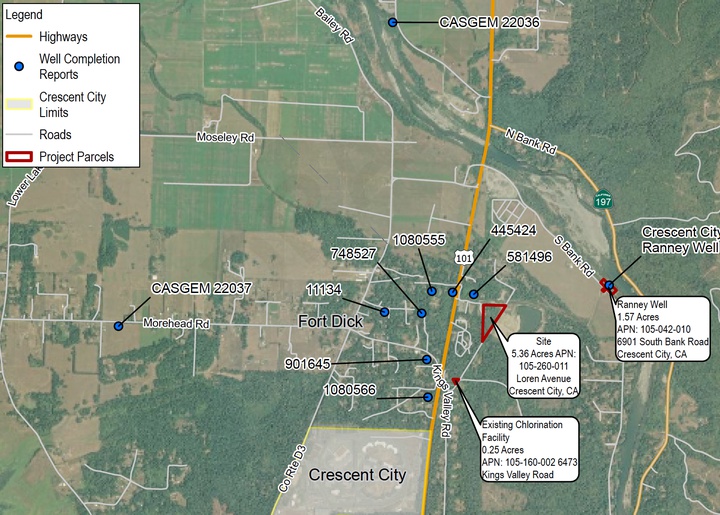Jessica Cejnar Andrews / Tuesday, Nov. 29, 2022 @ 3:26 p.m. / Infrastructure, Local Government
Though Its Sole Water Collector is Ticking Away Despite Its Age, Crescent City Wants a Secondary Source

The proposed project site near Loren Avenue in Fort Dick, along with the Ranney collector and chlorination facility. | Map courtesy of Crescent City
Crescent City is pursuing state Integrated Regional Water Management grant dollars to establish a secondary water source, though its sole source near the Smith River produces more than enough for the roughly 18,000 customers it serves.
The city aims to drill a 12-inch well capable of producing 415 gallons of water per minute. If the 64-year-old Ranney collector on South Bank Road was out of commission, this well, along with the city’s 5.5 million gallons of stored water, could sustain customers for up to 14 days, City Manager Eric Wier said.
As it stands, if the Ranney collector malfunctioned or if the Smith River’s water quality was compromised, the city has enough water in storage to serve its customers for about three days, Wier told the Wild Rivers Outpost on Tuesday.
The project is estimated to cost $1.3 million and is being considered for a 5-acre city-owned parcel on Loren Avenue in the Fort Dick area. This property houses the transmission mains that carry the water from the Smith River to town and is upstream from the city’s chlorination facility, Wier said.
But though a consultant, Irvine-based GHD Inc., finished a “desktop survey” determining a groundwater well would be suitable for that parcel, the project’s feasibility is still in question. As a result, it will include the drilling of a 6-inch exploratory well.
“This Fort Dick area is notorious for having good wells and not-so-good wells,” he told Crescent City Councilors last week. “The St. George formation, which is the bedrock out in this area, varies significantly. So that will be their first order of business, making sure this is a good site and this can produce the water we’re looking for it to produce and not have an effect on other groundwaters and well in this area.”
According to the city’s Nov. 21 staff report, its contractor would perform a 24-hour pump test to estimate the long-term yield, obtain water quality samples and evaluate the potential impact on nearby private wells. Once that test is finished, the 6-inch well could be used as a monitoring well or an emergency water source.
The project is expected to start in the spring and is set to be finished by 2025, Wier told the Outpost. The exploratory phase is expected to take about a year of that two-year timeframe, Wier said.
At their Nov. 21 meeting, Councilors received GHD’s report and ratified Wier’s signature on the proposed project application for Integrated Regional Water Management dollars. However, in addition to concerns about how the project would affect other wells, Councilors asked about cash flow, the project’s timeline and how rising construction costs would affect the city.
“The only thing that gives me anxiety is the construction cost risks that we’re going to have to absorb over this time period when they continue to soar,” Councilor Ray Altman said. “We’re responsible for any additional expenses over the grant besides our matching funds, correct?”
Crescent City Mayor Pro Tem Blake Inscore, pointing out that the grant would be paid out to the city in the form of a reimbursement for the project’s costs, asked about cash flow.
“Given everything else we have going on, are we in a position that we can manage this financially?” Inscore asked Wier.
Wier agreed that construction costs are a concern and that while contingencies are built in, he and other officials don’t know if it’s going to be enough.
“Say we drill that test well and it’s a year down the road and we say, ‘OK, yes we do want to move forward with this project’ and the project comes in at $5 million,” he said. “What then? With our conversations with the IRWM folks, at that point (the project) becomes unfeasible and we could simply disencumber the money.”
That funding would then go to another agency’s project, Wier said.
Wier also mentioned the cost of other potential water system projects, like the $5 million endeavor to replace the city’s aging water meters, saying that could have an impact on whether Crescent City moves forward with the secondary water source project.
Despite its age, the Ranney collector produces 10 million gallons of water per day. Crescent City’s customers use roughly 2 million gallons per day, Wier said.
In the nearly 20 years he’s worked for the city, Wier said the Ranney collector has been a reliable water source, though the city has had to replace pumps and other parts to keep it going.
According to Wier, if the well project doesn’t work for that 5-acre piece of land, city staff would have to consider another site.
CLICK TO MANAGE